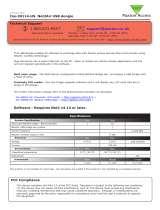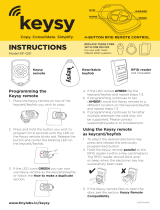
120 mm 120 mm 40 mm
11V DC 14V DC
80 mA
2.405 GHz 2.480 GHz
600 µs
1
Belden 9540
100 m
15 m
P38 850 mm
P50 1100 mm
P75 1500 mm
P200 2500 mm
2000 mm
-20 °C 55 °C
Specications
Voltage
Clock and data bit period
Carrier frequency
Operating temperatures - all items
Electrical
Environment
Dimensions
Max
Width
Height
Depth
Current
P200E metal mount
Readers per interface
Cable type for extensions
Cable length between ACU and reader
Distance between interface and reader
Read range with hands free token
System Specication
Waterproof
Additional power supply required
NO - If used externally, it must be protected in a plastic weatherproof housing
Button conrmation input
Yes
No
Min
Min
Min
Min
Max
Max
Max
1 - Hands Free - The read range is very poor - Where is the best position for the hands free interface?
QMount the interface within 15 m of the reader. The wireless signal will not travel through metal or water and will be inuenced
Qby building features and other 2.4 GHz wireless sources, including WiFi networks and DECT phones. The ideal location is to
Qprovide a 'line of sight' to approaching card users. Avoid putting the interface where metal objects, (e.g. wire fences, vehicles,
Qetc.) can block the signal. If it is to be used outside, it should be contained with a plastic weatherproof box. Do not use metal.
Q
QWhen attaching to a post, the interface should not be xed behind the metal backplate used to mount the reader. If used from
Qa vehicle, a high position is desirable to provide a path through the vehicle glass from keycard/fob to the hands free interface.
2 - Keycards - Can I improve the read range on curved driveways?
QIt is possible to parallel two or more hands free interface units onto the same ACU reader port, increasing the coverage area.
QThe keycard will choose one to communicate with each time it is used.
QSee also: AN1091 - How to achieve the best read range with hands free equipment < http://paxton.info/867 >
3 - How do I set up the Keycard Buttons?
QThe keycard must rst be read in hands free mode by the interface without pressing any buttons. Ensure that no other hands
Qfree devices are in the range of the reader. If the card does not enrol, come out of the reader range for at least 2 seconds.
QThe keycard has two buttons - each can store multiple interface addresses in its memory.
4 - Hands Free - Keycard button problems
QCorrect practice for using the keycards:
Q- Press button rmly once - Do not press the button again within 2 seconds - Avoid multiple button
Q presses in succession as this may overrun the output buffer of the interface locking it for 10 seconds.
Q- Point the Keycard in the direction of the interface - Avoid pressing a button when not in line of sight with the interface.
QEnsure switch SW2 on the Hands Free Interface is set to the correct position for the button being used (1 or 2).
5 - Net2Air - What does this mean?
QNet2Air is a term used to describe the wireless communication protocol used by Paxton products in much the same way
Qas Bluetooth. The Net2Air protocol is not open, only Paxton products can use this technology.
6 - If you power cycle the reader, the hands free token does not always read.
QHands free tokens have features to extend battery life. These include a block on repeated reads at the same door whilst the
Qkeyfob remains in range. If the token is read at power up, it must be moved out of range before it will be read again.
Here is the list of topics about this product that receive the most technical support enquiries.
We list them here to help you speed up the installation and trouble shooting process.
Technical Help
The declaration of conformity is available on request. Contact details are provided at: http://paxton.info/596





